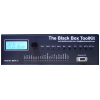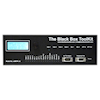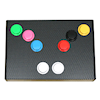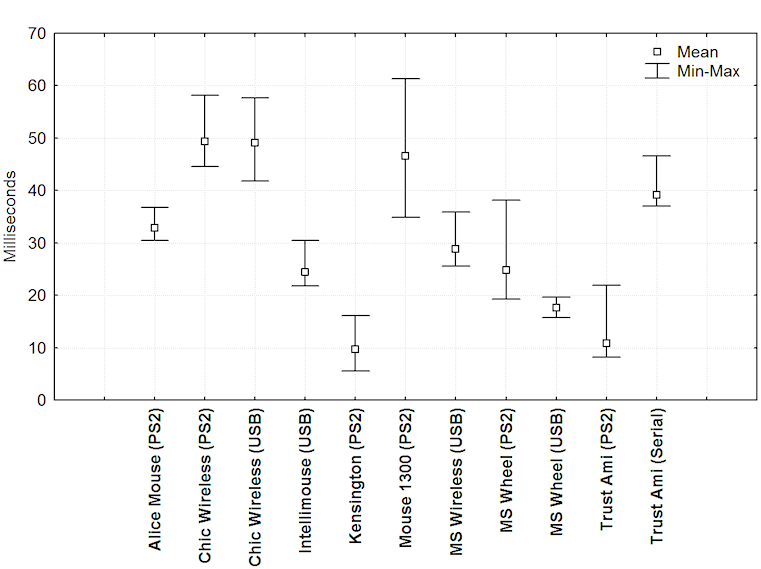Background
At the Black Box ToolKit we specialize in helping you achieve millisecond accurate presentation, synchronization, and response timing in your computer-based psychology experiments. Here are just a few of the things that can stop you doing just that!- TFT Input lag
- TFT response time
- Image intensity
- Sound card latency
- Response devices
- Voice keys
- 3rd party equipment
- OS issues
- Software settings
- Conditional biases
- The laws of physics




Need more help?
If you are unsure of how our products could work for you take a look at our What, Why and How pages. Answers to common application questions can be found in the FAQ section.If you have an application in mind but aren't sure, feel free to get in touch via email. Alternatively contact us by mail, phone or fax. We are here to help!
Keyboards and mice contribute to reaction time error in psychology experiments
 Keyboards and mice are not
generally designed to be fast input devices in absolute terms. As
with most components they are designed to be cheap and easy to
mass produce and not for measuring reaction times in psychology
experiments.
Keyboards and mice are not
generally designed to be fast input devices in absolute terms. As
with most components they are designed to be cheap and easy to
mass produce and not for measuring reaction times in psychology
experiments.Reported reaction times can vary when using a mouse or keyboard due to polling loops and the electronics in the keyboard or mouse. This means the timing error between pressing a key or button can be anywhere from 5 milliseconds to well over 100 milliseconds. As with other hardware their timing characteristics can very wildly between makes and models. Remember response error and variability introduced by your response device is in addition to the true reaction time! It's possible that differences between experimental conditions could purely be accounted for by your chosen response hardware.
Our own research published in Behavior Research Methods (Millisecond precision psychological research in a world of commodity computers: New hardware, new problems?) shows just how variable response error can be in a range of mice as the graph below shows.

Graph showing response time
error produced by a range of mice when connected to the same
PC.
Adapted from Plant & Turner (2009)
Adapted from Plant & Turner (2009)
Psychology Software Tools (PST) the authors of E-Prime have conducted their own tests where keyboards response time error varied even on the same PC (Dell Dimension 8400 3.0 Ghz). This is in no way the fault of E-Prime but rather the hardware and operating systems used.
| Operating System | Response Device | Mean Error (ms) | SD |
| Windows XP | Keyboard (USB Belkin) | 39.84 | 13.98 |
| Windows XP | Keyboard (USB Dell) | 8.30 | 0.74 |
Excerpt from PST's research
on response device latency
You are advised to view PST's full results which covers a range of keyboard and mouse hardware.
It should be noted that all keyboards and mice will suffer from response timing error regardless of computer hardware or operating system. What's more this will vary between make and model. PC and Mac will both have similar error rates as the majority of the error is caused by the keyboard or mouse itself. This is because all input devices constantly check for keys or buttons being pressed. They do this continuously in what is known as a polling loop. When they register a response this is sent to the computer and they carry on looping around.
Polling loops can be a real problem for professional computer gamers who rely on fast reaction times to earn money. Generally they use specialized mice that have a high DPI count (Dots Per Inch). In short the higher the DPI the faster or more responsive the mouse and in turn the less response time error. The video below shows just how fast the reactions of professional gamers is and why they demand the fastest hardware with the lowest latency.
ESReality have produced an "ESReality MouseScore 2007" measure for benchmarking mice based on some elaborate bespoke hardware shown below. You are advised to read their full report on benchmarking mice for gaming.

The ESReality MouseScore
benchmarking rig
References
Richard R. Plant and Garry Turner, "Millisecond precision psychological research in a world of commodity computers: New hardware, new problems?", Behavior Research Methods, 2009, Volume 41, Number 3, Pages 598-614.
